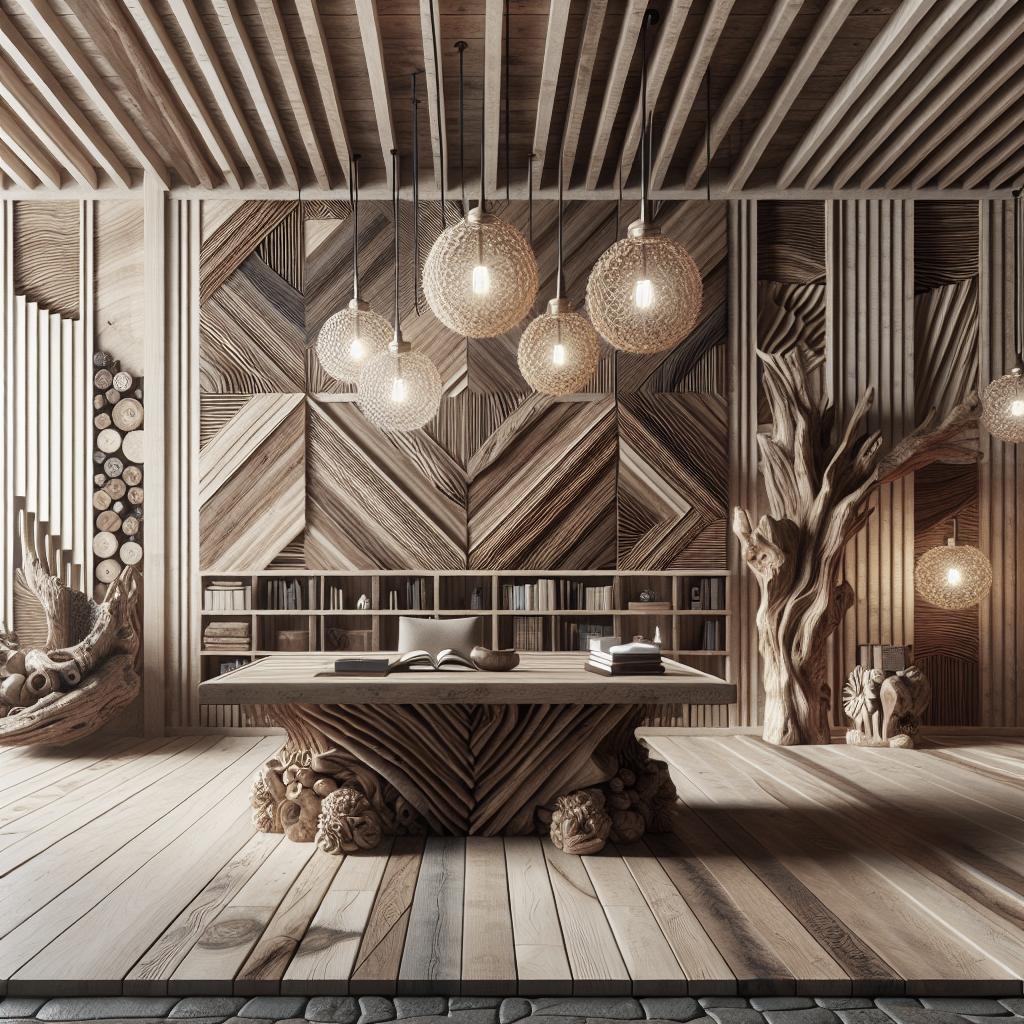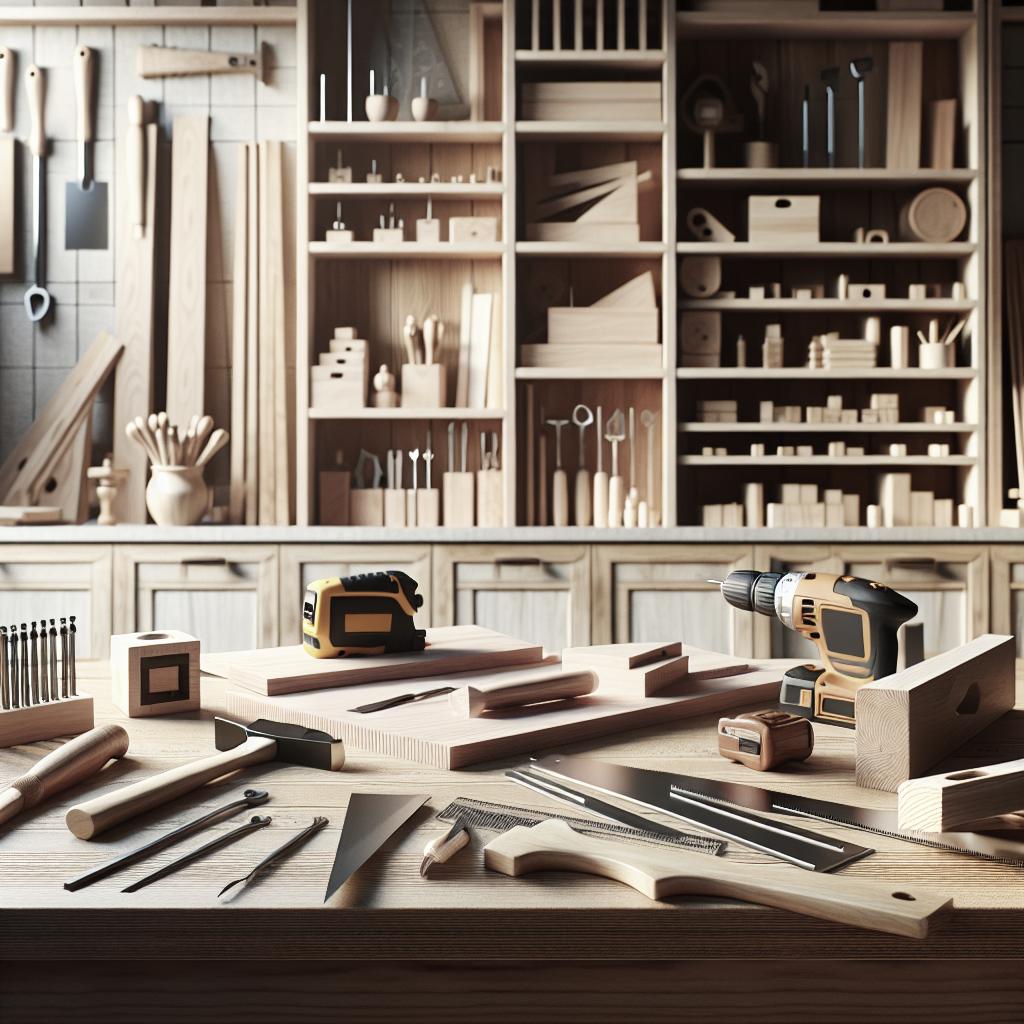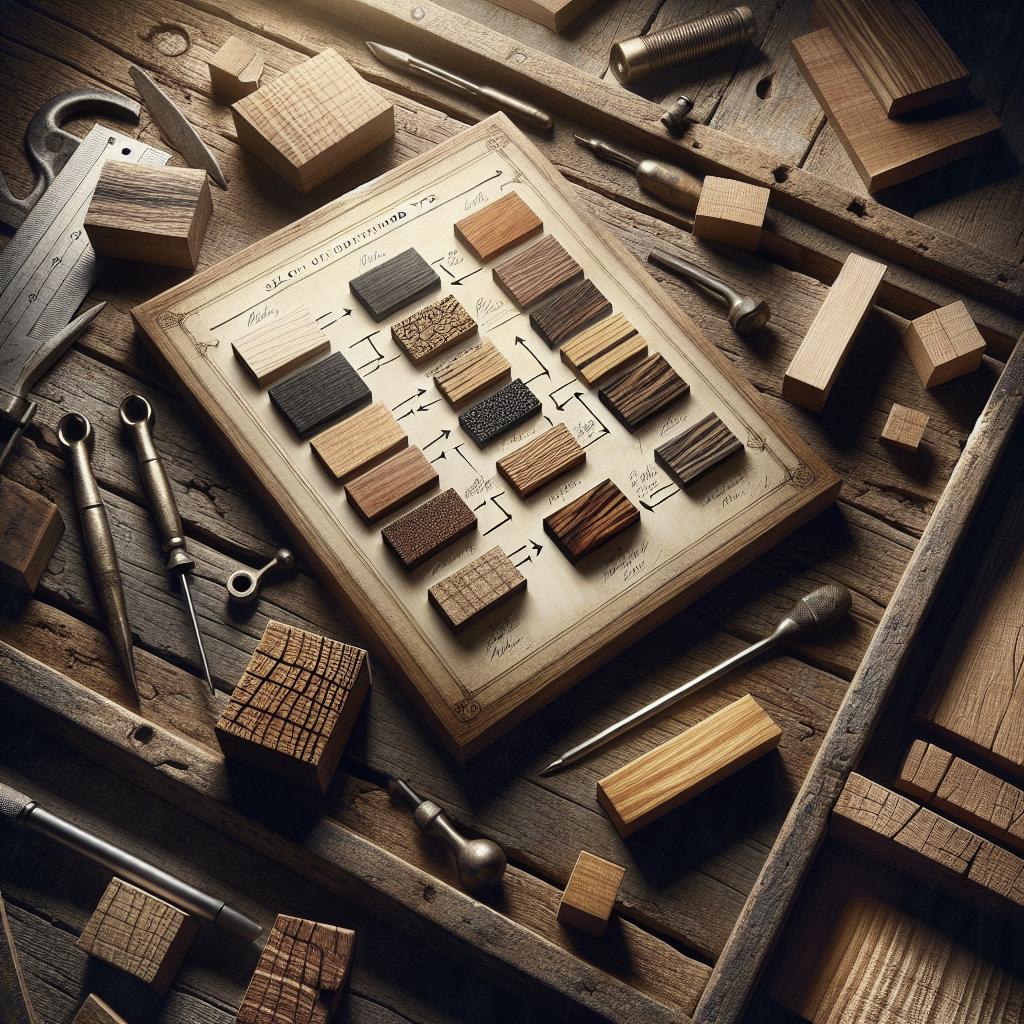“`html
Creative Uses of Wood in Interior Design
Wood has long been a favorite material in interior design due to its versatility, warmth, and connection to nature. In this blog post, we delve into how you can creatively incorporate wood into your home, from bold statement walls to intricate wood and glass combinations. Explore how wood can transform each room in your home and learn tips to accentuate your living spaces with wooden elements. Understanding harmonious combinations with other materials and choosing the right type of wood can offer both aesthetic and functional benefits. Whether you’re seeking a rustic charm or sleek modernity, find out how wood can revitalize your living space.
12 Crafty Ways to Add Wood Elements to Your Interior Design
1. Go Bold with a Wooden Statement Wall
A wooden statement wall can dramatically alter the ambiance of a room, serving as a focal point that draws attention. Whether you choose raw, reclaimed wood for a rustic appeal or sleek panels for a contemporary look, a wooden wall offers texture and warmth that paint or wallpaper simply can’t match. These walls can be customized to fit the overall aesthetic of your space, providing a perfect canvas for creativity.
Consider using different wood shades to create geometric patterns or opt for a single wood type with a striking finish. The intrinsic grain and natural tones provide a backdrop that complements a variety of decor styles. Additionally, a statement wall can transition a space, separating areas in open-plan homes with both visual and functional design.
2. Floors That Tell a Story
Wooden floors have the power to tell a story through their grains and finishes. The choice between hardwood, engineered wood, or reclaimed timber can greatly influence the ambiance of your home. Each type of wood flooring offers unique benefits, from durability to sustainability. Classic choices like oak and maple provide timeless elegance, while bamboo and cork deliver eco-friendly alternatives.
To emphasize the wood’s natural beauty, consider playing with staining techniques or laying patterns such as herringbone or chevron. These patterns can add a sophisticated touch that draws the eye and elevates the flooring from merely functional to artistically engaging. Wooden floors accommodate a range of styles, whether you’re looking to embrace traditional charm or contemporary chic.
3. Bring Nature Indoors with Wooden Furniture
Wooden furniture is a classic choice that’s as functional as it is aesthetic. Its ability to blend seamlessly into any decor style makes it a staple in interior design. From rustic farmhouse tables to sleek modern desks, the versatility of wooden furniture is unmatched. Investing in quality wooden pieces can also be a sustainable choice, with many artisans offering bespoke furniture made from responsibly sourced materials.
Wood furniture allows for a myriad of finishing options, including lacquered, stained, or raw finishes, each contributing differently to the feel of a space. Additionally, wooden furniture can be paired with a variety of textiles and materials to create a layered look. Incorporating wooden furniture pieces can instantly imbue any room with warmth and character.
4. Accentuate with Wood Accessories
Wooden accessories are an excellent way to incorporate natural elements without committing to larger structural changes. Whether it’s a wooden picture frame, a beautifully carved bowl, or a set of sleek coasters, these small touches can introduce warmth and texture into your space. They can also serve as conversation pieces and add a sense of personality and character.
Consider adding wood accents through shelving, mirrors, or handcrafted sculptures. These elements can be easily swapped out or adjusted, offering flexibility in styling. Moreover, pairing wood accessories with different materials like metals or ceramics can create contrast and add dimension to your decor.
5. Embrace the Charm of Wooden Ceilings
Wooden ceilings might not be the first thing you think of when considering wood in interior design, but they can be absolutely transformative. Wooden beams or paneling can add depth and warmth, creating an inviting atmosphere that embraces rustic charm. Ceiling applications can range from subtle planks to grand vaulted designs that become the focal point of a room.
The use of exposed wooden beams often complements styles like rustic, industrial, or even modern minimalist decor. Pairing wood with the right lighting can further accentuate the grain and color of the material, making it a key feature in the room’s architecture.
6. Wood and Greenery – A Perfect Match
Combining wood with greenery can cultivate a refreshing and serene environment within your home. Plants introduce life and color that complement the warm tones of wood, creating a tranquil space that feels both modern and organic. Whether with planters, shelves adorned with indoor plants, or wall installations, the marriage of these elements can revitalize any space.
Wooden plant stands or frames can be used to elevate greens, enhancing the room’s natural aesthetic. This combination fosters a visual connection to the outdoor world, inviting a breath of fresh air into urban settings or small apartments where outdoor space may be limited.
7. Wood and Glass Combinations
The pairing of wood and glass brings together warmth with transparency, creating a light and open feeling within a space. This combination is ideal for modern designs that prefer clean lines and an airy feel. Glass tabletops with wooden bases, glass cabinets with wood frames, or large wooden-framed windows can introduce a contemporary flair.
The reflective quality of glass juxtaposed with the natural texture of wood can enhance the visual interest without overwhelming the decor. Such combinations allow light to flow uninterrupted, making them perfect for maximizing natural light and creating the illusion of more space in compact areas.
8. Wood and Textiles
Textiles and wood are a harmonious match, offering an interplay of textures that enhances any interior space. Incorporate textiles such as rugs, throws, or cushions alongside wooden furniture for a cozy and inviting atmosphere. This balance of soft and hard elements creates a layered look that speaks to comfort and style.
In addition to aesthetics, textiles can also highlight wood’s natural textures, offering contrast and depth. Choosing complementary color schemes between your woods and fabrics can tie the room together, creating a cohesive design narrative. This approach suits various styles from bohemian to traditional.
9. Wood Dividers
Wood dividers are a practical and stylish way to segment space without constructing permanent walls. These dividers can take numerous forms, from slatted partitions that allow light through to solid, carved screens that provide intimacy. In open-concept areas, wood dividers can delineate zones such as living and dining spaces while maintaining flow.
The style and finish of the wood can echo the room’s design theme, whether that’s minimalist Scandinavian or detailed art deco. These versatile pieces can also be moved or adjusted as needed, providing flexibility in an evolving living environment.
10. Wood and Lighting
Incorporating wood into your lighting design adds warmth and texture while maintaining functionality. Wood can be used as lampshades, bases, or even as part of the light installation itself. This mix can create ambient lighting that adds character to a space, blending practicality with aesthetic appeal.
Combining wood with adjustable lighting options can highlight certain architectural features or artworks, emphasizing depth and dimension. These lights can work well in spaces that require visual emphasis, such as dining areas or living rooms, where mood setting is key.
11. Wood and Metal Fusion
Mixing wood with metals like steel, iron, or copper results in an industrial style that embraces both rustic and modern elements. This fusion can be seen in furniture items like metal-framed coffee tables with wooden tops, industrial shelving, and light fixtures that juxtapose wood’s warmth with metal’s edge.
Wood and metal combinations are perfect for creating a balanced yet bold aesthetic. These materials’ strengths lie in their durability and ease of maintenance, appealing to those who desire function without sacrificing style. This dynamic duo can blend vintage elements with contemporary trends beautifully.
12. Wood in Unexpected Places
Think outside the box when incorporating wood into your decor by using it in unexpected places. Integrate wood into home features like staircases, closet doors, or even kitchen backsplashes for a unique take on traditional design elements. Creative applications of wood can serve as a surprise element that evokes interest and conversation.
For instance, wooden handles or pulls on cabinetry add an unexpected twist to kitchen design, while a wooden bathtub can make a statement in contemporary bathrooms. These unconventional uses of wood showcase its adaptability and the endless possibilities it offers in interior design.
Infusing Wooden Elements into Your Interior Design by Room
Living Room
The living room is an ideal setting for integrating diverse wood elements due to its role as a central gathering spot in the home. Incorporate wooden coffee tables, shelving, or mantels to highlight the space’s warmth. Wooden elements in a living room can seamlessly unite its various aspects, much like the heart of the home.
Consider using different wood textures through flooring or accent walls to create a cohesive look. Adding wooden sculptures or frames can personalize the space, making it unique and reflective of individual style preferences.
Bedroom
In the bedroom, wood can create a calming and cozy atmosphere that’s conducive to relaxation. Wooden headboards, nightstands, and wardrobes introduce natural elements that promote a sense of tranquility. The choice of wood can influence the room’s overall mood, from dark walnut tones for a cozy feel to light pine or oak for an airy ambiance.
The introduction of wooden flooring or beams can further enhance the bedroom’s design, adding visual interest and textural contrast. Paired with soft linens and fabrics, wood elements can transform a bedroom into a sanctuary of rest.
Kitchen and Dining Room
Kitchen and dining areas benefit greatly from wood’s functional and aesthetic qualities. Wooden cabinets, counters, and dining tables serve as durable and attractive surfaces that can withstand daily wear and tear. These areas can be styled with consistent wood tones or contrasting shades for a dynamic visual statement.
A wood and metal or glass combination in these spaces can also offer a modern edge, fitting for contemporary homes. From traditional farmhouse tables to sleek wooden bar stools, the options are diverse for adding character and utility.
Bathroom
Using wood in bathrooms may seem unconventional, but it can bring warmth and sophistication when done correctly. Properly treated wood can withstand moisture, making it ideal for vanities, shelving, or accents that add an organic touch to the bathroom space. Teak is a popular choice due to its natural resistance to water.
The juxtaposition of wood against typically cool bathroom materials like tile and ceramics can create a balanced and inviting environment. This unexpected use of wood can redefine traditional bathroom aesthetics, offering a spa-like experience at home.
Tips to Accentuate Your HDB Flat With Wooden Elements
Choose the Right Wood Types
Choosing the right type of wood is crucial for emphasizing the desired ambiance and achieving longevity in HDB flats. Hardwoods like oak and teak offer durability while providing a premium look, whereas softer woods like pine or plywood can be more budget-friendly and easier to manipulate.
Consider the existing color palette and lighting in your flat, as lighter woods can brighten a space while darker ones provide dramatic contrast and define specific areas within an open layout.
Create Visual Contrast
Visual contrast can be achieved through the combination of different wood tones or by mixing wood with other materials. This approach adds depth and dimension to spaces, making them more visually stimulating. Use lighter wood finishes against darker wall colors or juxtapose wood furnishings with metallic accents to create a dynamic interior.
This technique allows flexibility and creativity in decorating schemes, making even the simplest HDB flats look sophisticated and layered in design.
Balance with Other Materials
Complement wood elements by balancing them with different materials such as metal, glass, or textiles. This balance not only maintains a harmonious environment but also prevents overwhelming the sense with too much uniformity. Introducing contrast through textures and finishes showcases wood’s versatility in design applications.
The key to this balance lies in careful selection and placement of elements, crafting an interior space that reflects a thought-out design philosophy.
Use Wood for Functional Storage
Wood can be both a decorative and a functional choice for storage solutions in any HDB flat. Built-in wooden cabinets, shelves, and closets not only maximize space but also add a polished and seamless appearance to any room. These solutions can be customized to fit the flat’s specific needs and design goals.
Wooden storage units offer durability and a classic touch that complements virtually any interior style. The incorporation of wood storage solutions facilitates organization without compromising on aesthetic appeal.
Final Thoughts
| Strategy | Description |
|---|---|
| Go Bold with a Wooden Statement Wall | Create a striking focal point with varied wood finishes and patterns. |
| Floors That Tell a Story | Choose wood flooring types and patterns that showcase character and style. |
| Bring Nature Indoors with Wooden Furniture | Opt for versatile wooden furniture to enhance warmth and character. |
| Accentuate with Wood Accessories | Add small wooden details for warmth and personality without major changes. |
| Embrace the Charm of Wooden Ceilings | Add depth and warmth with wooden beam or panel ceiling applications. |
| Wood and Greenery – A Perfect Match | Combine wood with indoor plants for a refreshing and calming space. |
| Wood and Glass Combinations | Create openness and light with wood and glass blends. |
| Wood and Textiles | Mix wood with fabrics for a cozy and stylish contrast. |
| Wood Dividers | Use wooden partitions to define and decorate open spaces. |
| Wood and Lighting | Incorporate wood in lighting for mood-setting warmth and style. |
| Wood and Metal Fusion | Blend wood with metals for an industrial yet refined look. |
| Wood in Unexpected Places | Use wood innovatively in areas like staircases or kitchen details. |
| Living Room | Use wood to unify this central living space with diverse elements. |
| Bedroom | Create a relaxing retreat with wooden furniture and accents. |
| Kitchen and Dining Room | Choose durable wood for kitchen cabinets and dining furniture. |
| Bathroom | Incorporate wood safely in moisture-prone areas for warmth and style. |
| Choose the Right Wood Types | Select woods that match durability and aesthetic goals within your flat. |
| Create Visual Contrast | Use contrasting wood finishes to add visual depth. |
| Balance with Other Materials | Balance wood with metals, glass, and textiles for cohesive design. |
| Use Wood for Functional Storage | Employ wood for storage solutions that enhance both function and form. |
“`


